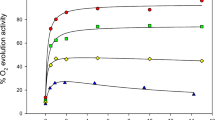Summary
Interface films of purple membrane and lipid containing spectroscopically intact and oriented bacteriorhodopsin have been used as a model system to study the function of this protein. Small positive charges in surface potential (<1 mV) are detected upon illumination of these films at the air-water interface. These photopotentials, are not affected by overlaying the interface film with a thin layer (0.3 mm) of decane. However, they are dramatically increased when lipid soluble proton carriers FCCP or DNP are added to the decane. The polarity of the photopotential indicates that, in the light, positive charges are transported through the interface from the aqueous to the organic phase. The action spectrum of the photopotential is identical to the absorption spectrum of bacteriorhodopsin. Since bacteriorhodopsin molecules are oriented with their intracellular surface towards the aqueous subphase, the characteristics of the photopotential indicate that in the light bacteriorhodopsin translocates protons from its intracellular to its extracellular surface. The kinetics of the photopotential reveal that the rate and extent of proton transport are proportional both to the fraction of bacteriorhodopsin molecules excited and to the concentration of proton acceptor. The photopotentials result from changes in the ionic distribution across the decane-water interface and can be cancelled by lipid soluble anions.
Similar content being viewed by others
References
Bakker, E.P., Rottenberg, H., Caplan, R. 1976. An estimation of the light induced electrochemical potential difference of protons across the membrane ofHalobacterium halobium.Biochim. Biophys. Acta 440:557
Blaurock, A.E., Stoeckenius, W. 1971. Structure of the purple membrane.Nature New Biol. 233:152
Bogomolni, R. 1977. Light energy conservation processes inHalobacterium halobium cells.Fed. Proc. (in press)
Bogomolni, R., Baker, R., Lozier, R., Stoeckenius, W. 1976. Light-driven proton translocation inHalobacterium halobium.Biochim. Biophys. Acta 440:68
Boguslavsky, L.I., Kondrashin, A.A., Kozlov, I.A., Metelsky, S.T., Skulachev, V.P., Volkov, A.G. 1975. Charge transfer between water and octane phases by soluble mitochondrial ATPase (F1) bacteriorhodopsin and respiratory chain enzymes,FEBS Lett. 50:223
Danon, A., Stoeckenius, W. 1974. Photophosphorylation inHalobacterium halobium.Proc. Nat. Acad. Sci. USA 71:1234
Davies, J.T., Rideal, E.K. 1955. Interfacial potentials.Can. J. Chem. 33:947
Davies, J.T., Rideal, E.K. 1963. Interfacial Phenomena. Academic Press, New York
Dean, R.B., Gatty, O., Rideal, E.K. 1940. Absorption potentials.Trans. Faraday Soc. 36:161
Drachev, L.A., Frolov, V.N., Kaulen, A.D., Liberman, E.A., Ostrumov, S.A., Plakunova, V.G., Semenov, A.Y., Skulachev, V.P. 1976. Reconstitution of biological molecular generators of electric current.J. Biol. Chem. 251:7059
Drachev, L.A., Kaulen, A.D., Ostroumov S.A., Skulachev, V.P. 1974. Electrogenesis by bacteriorhodopsin incorporated in a planar phospholipid membrane,FEBS Lett.39:43
Haydon, D.A. 1964. The electrical double layer and electrokinetic phenomena.Recent Prog. Surf. Sci. 1:94
Haydon, D.A., Hladky, S.B. 1972. Ion transport across thin lipid membranes: A critical discussion of mechanisms in selected systems.Q. Rev. Biophys. 5:187
Henderson, R. 1975. The structure of the purple membrane fromHalobacterium halobium: Analysis of the X-ray diffraction pattern.J. Mol. Biol. 93:123
Herrmann, T.R., Rayfield, G.W. 1976. A measurement of the proton current generated by bacteriorhodopsin in black lipid membranes.Biochim. Biophys. Acta 443:623
Hwang, S.-B., Korenbrot, J.I., Stoeckenius, W. 1977. Structural and spectroscopic characteristics of bacteriorhodopsin in air-water interface films.J. Membrane Biol. 36:115
Hwang, S.-B., Stoeckenius, W. 1977. Purple membrane vesicles: Morphology and proton translocation.J. Membrane Biol. 33:325
Kayushin, L.P., Skulachev, V.P. 1974. Bacteriorhodopsin as an electrogenic proton pump: Reconstitution of bacteriorhodopsin proteoliposomes generating ΔΨ and ΔpH.FEBS Lett. 39:39
Ketterer, B., Neumcke, B., Lauger, P. 1971. Transport mechanism of hydrophobic ions through lipid bilayer membranes.J. Membrane Biol. 5:225
Korenbrot, J.I. 1977. Some consideration on the ion transport properties of rod disc membranes.Biophys. Struct. Mechanism
Liberman, E.A., Toplay, A. 1968. Selective transport of ions through bimolecular phospholipid membranes.Biophys. Biochim. Acta 163:125
Lozier, R.H., Niederberger, W., Bogomolni, R.A., Hwang, S.-B., Stoeckenius, W. 1976. Kinetics and stoichiometry of light-induced proton release and uptake from purple membrane fragments,H. Halobium cell envelopes, and phospholipid vesicles containing oriented purple membrane.Biochim. Biophys. Acta 440:545
McLaughlin, S. 1972. The mechanism of action of DNP on phospholipid bilayer membranes.J. Membrane Biol. 9:361
Mitchell, P. 1961. Coupling of phosphorylation to electron and hydrogen transfer by a chemiosmotic type of mechanism.Nature (London) 191:144
Oesterhelt, D. 1975. The purple membrane ofHalobacterium halobium: A new system for light energy conversion. Ciba Foundation Symposium 31 (new series): 147. Elsevier, Amsterdam
Oesterhelt, D., Stoeckenius, W. 1973. Function of a new photoreceptor membrane.Proc. Nat. Acad. Sci. USA 70:2853
Parsegian, A. 1969. Energy of an ion crossing a low dielectric membrane: Solution to four relevant electrostatic problems.Nature (London) 221:844
Racker, 1973. A new procedure for the reconstitution of biological, active phospholipid vesicles.Biochem. Biophys. Res. Commun. 55:224
Racker, E., Hinkle, P.C. 1974. Effect of temperature on the function of a proton pump.J. Membrane Biol. 17:181
Racker, E., Stoeckenius, W. 1974. Reconstitution of purple membrane vesicles catalyzing light-driven proton uptake and adenosine triphosphate formation.J. Biol. Chem. 249:662
Renthal, R., Lanyi, J.K. 1976. Light-induced membrane potential and pH gradient inHalobacterium halobium envelope vesicles.Biochemistry 15:2136
Romeo, D., Hinckley, A., Rothfield, L. 1970. Reconstitution of a functional membrane enzyme system in a monomolecular, film.J. Mol. Biol. 53:491
Shieh, P., Packer, L. 1976. Photo-induced potentials across a polymer stabilized planar membrane in the presence of bacteriorhodopsin.Biochem. Biophys. Res. Commun. 71:603
Stoeckenius, W., Hwang, S.-B., Korenbrot, J.I. 1977. Proton translocation by bacteriorhodopsin in model systemsIn: Structure of Biological Membranes. S. Abrahamsson and I. Pascher, editors. Plenum Press, New York
Verger, R., Pattus, F. 1976. Spreading of membranes at the air/water interface.Chem. Phys. Lipids 16:285
Author information
Authors and Affiliations
Rights and permissions
About this article
Cite this article
Hwang, SB., Korenbrot, J.I. & Stoeckenius, W. Proton transport by bacteriorhodopsin through an interface film. J. Membrain Biol. 36, 137–158 (1977). https://doi.org/10.1007/BF01868148
Received:
Issue Date:
DOI: https://doi.org/10.1007/BF01868148




